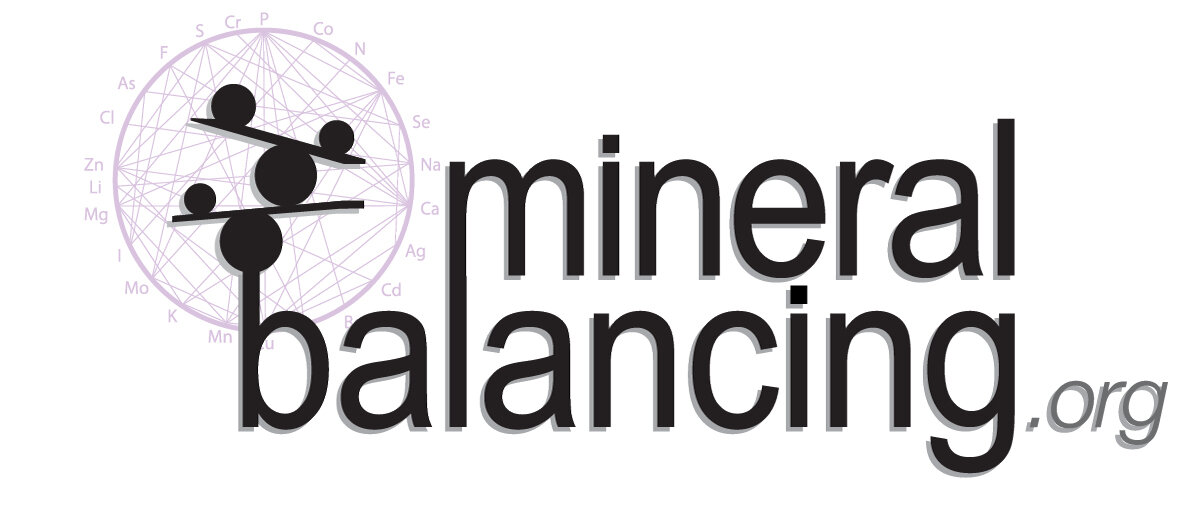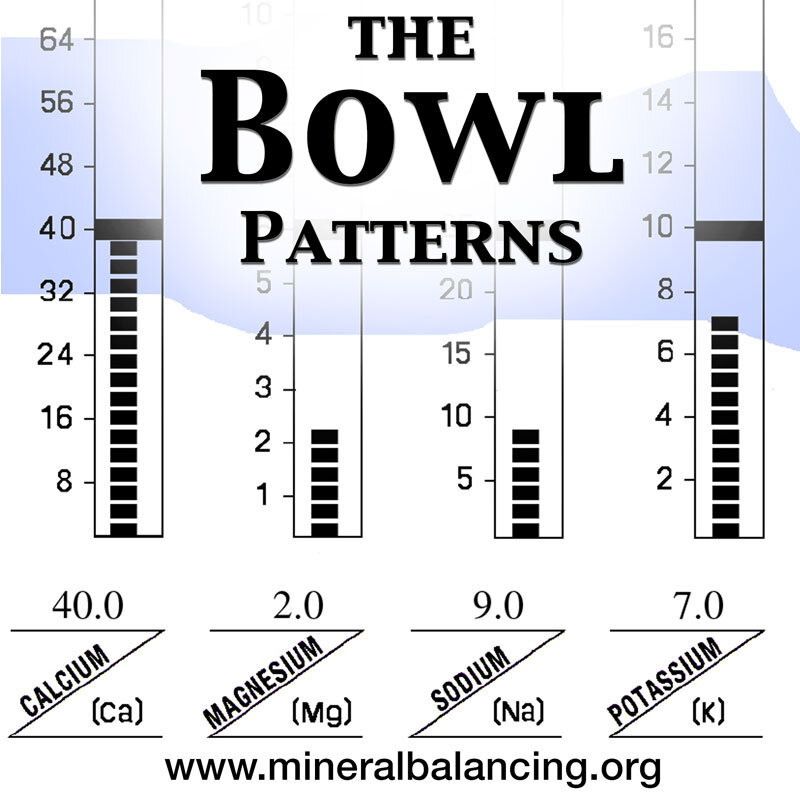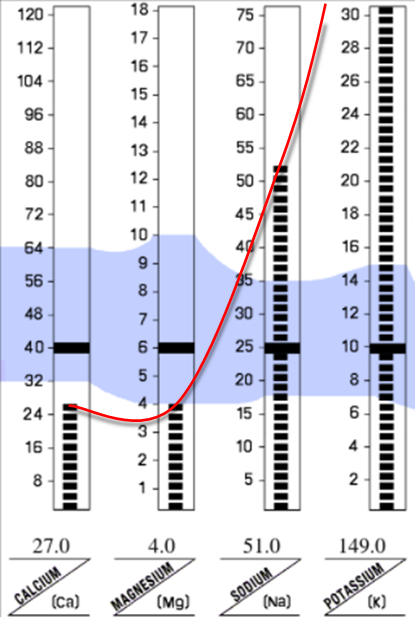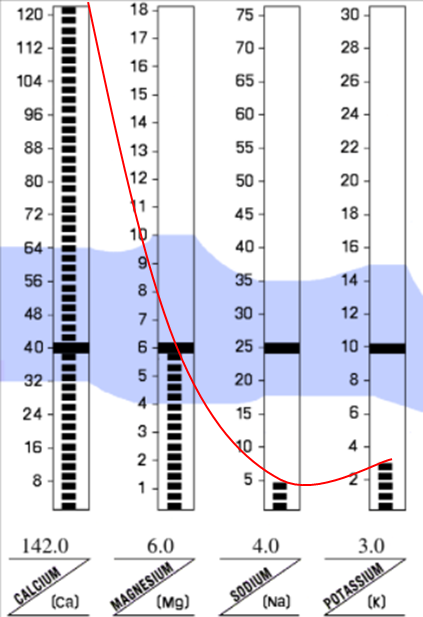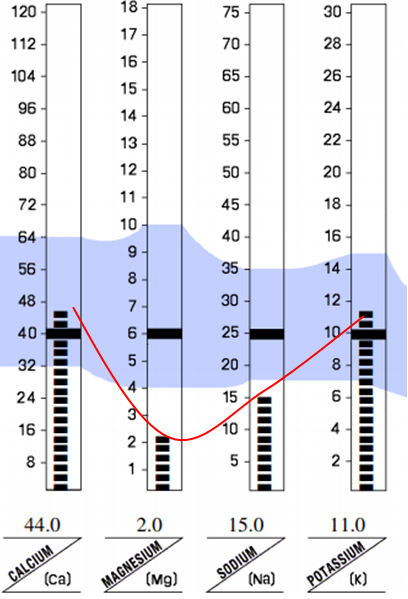Bowl Patterns
Many different patterns can be found on a Hair Tissue Mineral Analysis (HTMA). One of the more common patterns that we see, are quite visual – The Bowl Patterns. As always, for the HTMA patterns that we discuss on this website, this pattern is only relevant on hair tests that were not washed during the laboratory analysis. Since the washing procedure can affect the electrolyte levels (G S Assarian, 1977; Leroy, 1986), which can be misleading during the interpretation of the results.
Definition
Just like many other HTMA patterns, the Bowl Pattern is the result of superimposed ratios. This pattern, whether it is a Fast Bowl or a Slow Bowl, consists of both low sodium to potassium ratio (Na/K) and an elevated calcium to magnesium ratio (Ca/Mg).
The Na/K ratio must be less than 2.5/1, while the Ca/Mg ratio must be higher than 9.5.
When a person is in a Bowl Pattern, they exhibit much of the signs and symptoms that are a result of these ratios such as:
Low Na/K ratio, such as adrenal insufficiency, low hydrochloric acid and a compromised immune system to name a few.
An elevated Ca/Mg ratio, such as blood sugar dysregulation, calcification of the tissues, and bone depletion. There is often an increased risk of CVD, in particular, an increased Coronary Calcification Score when this ratio is elevated on an HTMA (Byoungjin Park, 2017).
This pattern can be identified visually on an ARL HTMA quite simply. It looks like the side of a bowl, hence the name of the pattern. It may not be as easily identifiable if some, or multiple macrominerals are off the chart.
Very often, those that are in this pattern often struggle to digest protein.
Mental/Emotional Aspects
Generally, those that are in this pattern are quite introverted, and unable to overcome obstacles in their life. They are often exhausted, both physically, but also mentally at trying to resolve their conflicts. Socially, individuals in a bowl pattern are quite introverted. They tend to start projects, but they generally never complete them. These individuals are often ‘lost’ on their journey to health and often need guidance.
In some instances, individuals in a Bowl Pattern are high achievers, but they thrive on adrenal stress hormones. This tendency further compiles their exhaustion, so they may seek out stimulants so that they can maintain their lifestyle.
This pattern is much easier to correct than the Four Lows Pattern, and it can resolve as quickly as 3 months, but generally no longer than 12 months while on a Mineral Balancing Program.
Variations
By definition, the Bowl Pattern consists of two ratios and not mineral levels. So, this pattern can vary quite a bit.
The two most broad variations of this pattern are the Fast and Slow Bowl Patterns. While other variations are generally due to a more pronounced imbalance of the ratios, or with other patterns such as a Four Low Bowl or a Four High Bowl. There can also be shallow bowls, and deep bowls depending on the mineral levels and the ratios. I have shared some examples of them in the gallery below.
In general, many of these variations still retain the initial signs and symptoms of the imbalanced ratios, but they can be more pronounced as the ratios are further out of balance, or if there are other patterns present such as a Calcium Shell, Four Low’s, etc.
Note: When a person has a Fast Bowl Pattern, they are not really in a state of true fast oxidation. Instead, they are in a state of exhaustion with an alarm stage of stress superimposed. The correction of the Fast Bowl Pattern is very different to that of the Slow Bowl.
Retest
This pattern can occur on a retest, which can change its meaning, especially when it indicates a Slow Bowl Pattern. When a person is following a properly designed Mineral Balancing Program, the calcium level can raise due to the elimination of some biounavailable calcium that was in the body, this causes a pseudo elevated ca/mg ratio. However, these individuals often will have more work to do as they will still be in a state of exhaustion, even if they feel like their health has improved.
Nutritional Correction
In my experience, the bowl pattern often needs a lifestyle change, in addition to a comprehensive nutritional Mineral Balancing Program.
The Bowl Pattern is often the result of multiple nutritional insufficiencies, which can be the result of chronic stress, and a hydrochloric acid deficiency. They always have a low cellular thyroid and adrenal gland function. Therefore, it is critical to provide nutrients that are designed for the Slow Metaboliser, as well as nutrients that raise sodium, so that you can correct the sodium to potassium inversion.
Since those in a Bowl Pattern have a low cellular thyroid activity, regardless of the Ca/K ratio, I have found that iodine can be quite helpful, especially when a good metabolic multivitamin and mineral is provided.
Since the bowl pattern is characterised by having a low Na/K ratio, I find that it is essential for them to be on Betaine HCL as well as a broader digestive enzyme such as Digest Gold.
The Fast Bowl Pattern, is unique in that it requires a very special program. They still require thyroid support, but oftentimes they need a special metabolic product that is high in copper to raise their calcium and get them back into a state of slow oxidation.
Both Fast and Slow Bowls do quite well on the Slow Oxidiser Dietary Guidelines. However, the Fast Bowl may require more dietary fat.
References
Byoungjin Park, M.-H. K.-J.-C. (2017). High Calcium–Magnesium Ratio in Hair Is Associated with Coronary Artery Calcification in Middle-Aged and Elderly Individuals. Biological Trace Element Research, 195, 52-58. Retrieved from https://link.springer.com/article/10.1007%2Fs12011-017-0956-8
G S Assarian, D. O. (1977, Sept). Effect of washing procedures on trace-element content of hair. Clinical Chemistry, 23(9), 1771-1772. doi:doi.org/10.1093/clinchem/23.9.1771
Leroy, R. F. (1986). Effect of Washing on Trace Element Content of Human Hair. Journal of Orthomolecular Medicine, 1(2). Retrieved from http://orthomolecular.org/library/jom/1986/pdf/1986-v01n02-p120.pdf
